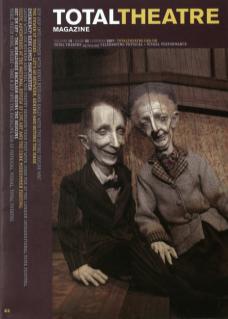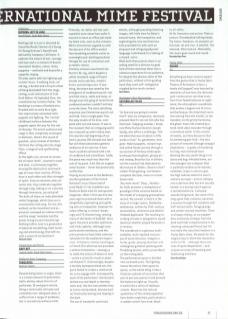Despite being Swiss in origin, there is a certain amount of pessimistic Gallic whimsy about this trio of performer, DJ and giant revolve. Being a technically intricate and somewhat over-designed show, it suffers from a range of problems, but is not entirely without mirth.
Primarily, its rather old-hat anti-capitalist tone about how awful it must be to have an office job made my heart sink, even as the virtuosic Martin Zimmermann regaled us with the descent of his office worker from bumbling erstwhile victim to overweight pod-dwelling bachelor through his use of contortion and acrobatic mania. Similarly virtuosic was Dimitri de Perrot's DJ-ing, which despite a rather standard range of found sounds and scratches, mixed a hectic and driving score. If anything, the piece was saved by the emergence of cardboard punch-out and fold chairs, table and lamp, although even the gang of recalcitrant cardboard workers couldn't entirely carry the show. The most satisfying sequence saw Zimmermann punch out and fold, from a single gate-flat, the poky studio of his hero, complete with cat and mouse. It was in this moment that an intriguing world was conjured up and in many ways this was the real beginning of our hero's journey (50 minutes too late). But still there persisted a general ambience of an exercise in how much could be achieved with a lot of cardboard and a briefcase. Sadly the piece was much less than the sum of its parts. A bit like an origami water bucket – clever but practically ineffective. Playing across town at the Barbican, another graduate of the French National Circus School and of Josef Nadj's Cri du Caméléon was Mathurin Bolze with his new quartet Tangentes. When I first saw him two years ago he promised much with a delightfully captivating and uplifting solo on trampoline. However, his latest offering is a heart-breakingly arid 75 minutes long, sharing many of the faults of Gaff Aff. Once again the piece provides spectacle and tricks aplenty, although none particularly revelatory, and the piece proves to have little cohesive rationale for the audience's experience. It features clumsy monologues in French (for which we are provided a written translation – leaving us to make the choice of where to look – surely a crime for visual or physical theatre?). Distressingly, despite a lavishly dystopian bleak set, the piece failed to create a valid world for us to engage with. Consequently, each of the performers' interactions lacked any real depth or development and, like the marionettes they at times manipulated, became bodies frantically waving and leaping in the dark The use of treadmills and tread wheels, although providing diverting images, left little time for Bolze's natural home, the trampoline, and neglecting the very tool that last time provided him with such an eloquent and intriguing physical language contributed to a feeling of a muted-voice. What both these pieces share is an aching need for a director to grab hold of them and beat them into a cohesive experience for an audience, for despite the obvious skills of the performers, without a firm guiding hand they seem self-indulgently crippled by too much content.

